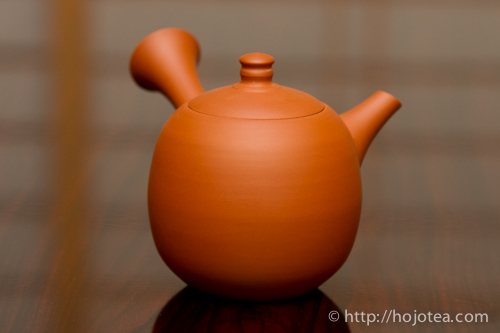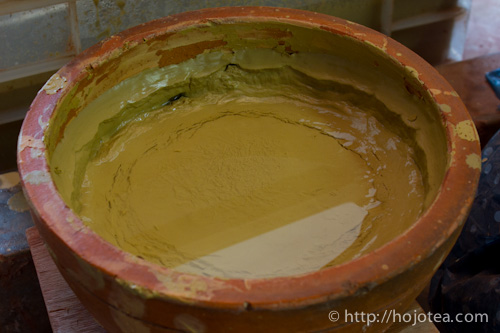- HOME >
- Teapot and Tea Equipment
Why is Zhuni/Shudei so famous?
Zhuni and red clay is of different meanings
Zhuni is a famous name of clay. For teapot collectors in China and Japan, this name is very familiar. Both in Japanese and Chinese,it is written as 朱泥. Zhuni is the Chinese pronunciation, while it is called Shudei in Japanese. Both languages are referring to exactly the same clay. Nonetheless, Zhuni and red clay is not the same. The word of “Zhu” in Zhuni is refers to one specific colour, as shown in the following website:
http://www.colordic.org/colorsample/2245.html
Technically, “Zhu” is referring to the colour called vermilion. It is bright orange colour. This is supposed to be the colour of Zhuni and it has less impurity. The Zhuni’s crude clay is beige in colour. Once it is baked up to 1100 degree C, and it turns into vermillion. When the baking temperature reaches 1200 degree C, the colour turns maroon.
The Zhuni’s performance towards the taste of tea
Do you know why the name “Zhuni” became so famous?
It is because of its outstanding performance. The Zhuni teapot makes the taste of tea becomes soft, smooth and the flavour is very long lasting. A distinctive characteristic of Zhuni teapot is that it is suitable for all kinds of tea,such as Wuyi oolong, Tie Guan Yin and all types of other tea. Based on my own study, and also the knowledge I learned from potters in Japan and China, Zhuni has following 2 characteristics:
- Clay contains extremely fine particles, therefore it is very sticky and elastic.
- Clay is rich in iron
- Clay contains less percentage of zinc, copper or magnesium.
The difference between Hongni and Zhuni
In general, many types of clay contain iron. In particular, Hongni (紅泥) is very rich in iron content too. The crude so-called Hongni clay is reddish-orange, and it was found in both China and Japan. The Mumyoi clay of Sado Island is exactly this type of clay, while the Nosaka clay is similar to Zhuni. As the characteristic of Hongni, it contains bigger particles compared to Zhuni. As a result, Hongni lacks elasticity but has sand texture. Due to bigger particle size, the firing temperature is quite high (up to 1200 degree C),that makes the porosity smaller than Zhuni. The firing temperature of Zhuni is about 1100 degree C. Thanks to its finer particle size, it can be baked at lower temperature while maintaining higher porosity. With higher porosity means it gives larger surface area and it releases more iron ion into tea or water.
For Zhuni teapot both in Japan and China, the mainstream is the blended clay
The agricultural practice affects the resourcces of clay
In fact, in the past, Tokoname used to produce good Zhuni. It was called Hon Shudei. At that time, there were plenty of rice fields and clay was collected when the soil of rice field was turned around. For now, the farmer stopped this practice since it is placed by the chemical fertilizer. As the result most of the Tokoname potters are unable to personally collect the clays. Instead, they buy clays from the Tokoname clay association, who specialized in blending clays.
Very few people pay attention to the effect of clay on the taste of tea
Different clays have a different impact to the taste of tea. Some clay teapots should be able to enhance the taste and flavour of tea, while certain clays might diminish the characteristic of tea. Unfortunately, this is not being taken seriously. Many people generally believe that any clay has the same effect. In fact, different clays have different minerals, and its effect on tea could be positive or negative. To my point of view, blending is nothing wrong, if the effect to the taste and flavour of tea has been carefully monitored. Nowadays, the common phenomenon is clay is mixed merely to achieve the colour effect. If the clay is blended only for the sake of colour, it could hardly perform well.
Iron oxide is added to achieve the red color
In addition, both in Japan and China, it is a very common practice that oxidized iron powder is added into white clay or any clay in order to produce clay in red colour. Iron oxide is harmless, since it is just ground into the iron powder by mechanical machining. The natural clay contains the iron crystals and its melting point is very high. As for the artificially added iron oxide, it started to melt at about 600 degree C.The artificially-added iron oxide liquefies and starts covering the surface of other minerals. It is same like glazing effect. As a result, the clay will lose the porosity and it can hardly release the iron ion.
The usage of iron oxide flects in the outlooks of clay
In fact, we can briefly tell if a teapot is made of artificially clay blended with iron oxide. The surface is unnaturally shiny and it’s not matt surface. If it is made of authentic Zhuni and it is baked until the surface is glossy, it should turns maroon. Whether an artificially-blended clay should be called as Zhuni is depends on the potters. Nonetheless, the performance of artificial-blended clay is distinguishable. In any case, the natural Zhuni can make tea tastes very soft and smooth.
Using tea to assess clays’ performance
This is one of the methods to evaluate the effect of clay on the taste of tea. I could imagine that many comments would say that there is no change of taste or it is not logical. Based on our experiences after conducting many tea evaluations and demonstrations, nearly 70% of people could tell the differences, as long as the clay we used for this experiment is of right quality. Out of these 70% of people, only about 20% of them are particularly sensitive; they were shocked by the effect of clay on tea when they tasted tea from different clays. It is just like the world of wine. Good wine has a very long finishing and its flavour stays for a long time with reasonable extent of body. However, quite a number of people tends to pay more attention to the wine’s aroma and less aware of “after taste” (finishing). There are similar examples in sound system. Not everyone could understand and appreciate the clear differences in the high-end sound system, like Hi-Fi or Stradivarius violin. Most importantly, one must be aware of “after taste” and be able to tell the different extent after taste. With such ability, you will then be able to experience the performance of different clays, especially with quality clay that has an ability to alter the taste of tea.
Related Articles
How to get the latest update on HOJO?
1. Follow Twitter, 2. Click "Like" on Facebook, and 3. Subscribe in newsletter. You can have the latest tea news from HOJO.
 Subscribe the Newsletter to enjoy the privileges
Subscribe the Newsletter to enjoy the privileges- You may receive a free sample upon purchase, or you may have the priority to purchase special products. So please remember to subscribe our newsletter as well as the social network.
- Myanmar White Tea Bud 2013 from Guo Gan, Myanmar
- We have released a raw Pu-erh tea, 緬甸白芽茶 2013 (Myanmar White Tea Bud 2013), produced by ethnic minorities in t …
- Yong De Wild White Tea 2025 Loose Leaf Limited Release
- We have released Yong De Wild White Tea Loose 2025. For the 2025 harvest, only the loose-leaf type was …
NEW ARTICLES
 Myanmar White Tea Bud 2013 from Guo Gan, Myanmar
Myanmar White Tea Bud 2013 from Guo Gan, Myanmar- We have released a raw Pu-erh tea, 緬甸白芽茶 2013 (Myanmar White Tea Bud 2013), produced by ethnic minorities in t …
 Yong De Wild White Tea 2025 Loose Leaf Limited Release
Yong De Wild White Tea 2025 Loose Leaf Limited Release- We have released Yong De Wild White Tea Loose 2025. For the 2025 harvest, only the loose-leaf type was …
 Experience the True Freshness of Raw Pu-erh : Tang Jia 2025 Loose Leaf Release
Experience the True Freshness of Raw Pu-erh : Tang Jia 2025 Loose Leaf Release- We have released Tang Jia Raw Pu-erh Tea 唐家古樹生茶 2025 Loose Leaf. Among HOJO’s raw pu-erh teas, Tang Jia Raw Pu …
 Yunnan Chun Jian Green Tea from High Mountain Gardens
Yunnan Chun Jian Green Tea from High Mountain Gardens- Yunnan Chun Jian Green Tea is now available. This tea is made from naturally grown leaves harvested from high …
 Limited Loose Leaf Release of 2025 Da Xue Shan Wild Raw Pu-erh Tea
Limited Loose Leaf Release of 2025 Da Xue Shan Wild Raw Pu-erh Tea- We have released the 2025 loose-leaf version of Da Xue Shan Wild Raw Pu-erh Tea. This tea comes from wild tea …
 Discover a New Way to Enjoy Tea: Cooking Rice with Tea
Discover a New Way to Enjoy Tea: Cooking Rice with Tea- Cooking rice with tea is a simple idea, but it brings surprisingly satisfying results. The tea’s flavour seeps …
 2025 Da Xue Shan Wild White Tea Now Available from Yunnan
2025 Da Xue Shan Wild White Tea Now Available from Yunnan- The 2025 harvest of Da Xue Shan Wild White Tea is now available. Crafted from truly wild Camellia taliensis tr …
 Fresh 2025 Yunnan White Tea – Select Your Favourite Lot Before Blending
Fresh 2025 Yunnan White Tea – Select Your Favourite Lot Before Blending- Freshly crafted in Yunnan and just arrived in KL, our new 2025 white tea is now available at our Gardens Mall …
 2024 Dong Shan Raw Pu-erh Tea – Crafted with the Producer for Desired Quality
2024 Dong Shan Raw Pu-erh Tea – Crafted with the Producer for Desired Quality- We have released the 2024 cake of Dong Shan Raw Pu-erh Tea. Earlier, we offered the loose-leaf version from th …
 Development of Firewood Roasted Hojicha Using Naturally Grown Tea from Yunnan
Development of Firewood Roasted Hojicha Using Naturally Grown Tea from Yunnan- We are currently staying in Yunnan Province for tea production. As the season nears its end, tea trees with pa …
Category
- New Arrival at HOJO Online Shop
- Featured Articles
- Newsletter
- Types of Tea
- Origin of Tea
- Teapot and Tea Equipment
- Tea Column
- How to enjoy tea
- Tea Processing
- How to choose quality tea
- Tea constituents and functional effect
- Safety of Tea
- Foods
- Tea Business Operation
- Hobby and Outdoor Activity
- Ranking of Tea
- Video
- FAQ
- Media Release
Profile

- AKIRA HOJO
- I invite you to experience my tea selections.I was born in Nagano, Japan. In university, I studied agricultural chemistry, and I have the master degree in food science. I worked in Japanese food industry for 10 years. I involved in R&D, QC and QA. As a factory manager, I implemented ISO9000 series and managed the factory.
- The Art of Tea Magazine
- We posted the article on “The Art of Tea Magazine No.9, the magazine is published in Taiwan. We featured …
- New Straits Times
- The Malaysian National Newspaper, New Straits Times featured HOJO Tea on 17-Oct-2007.
Shop Info

Address:Lot No. T-215, 3rd Floor, The Gardens Mall, Mid Valley City, Lingkaran Syed Putra, 59200 Kuala Lumpur
Tel: +603-2287-4537
Business Hour: 10am to 10pm



















